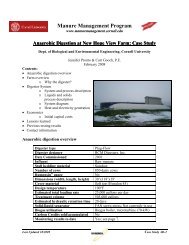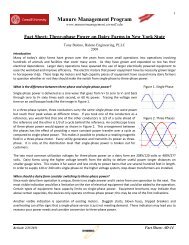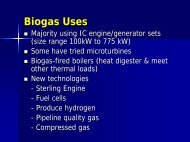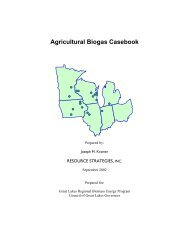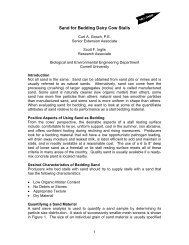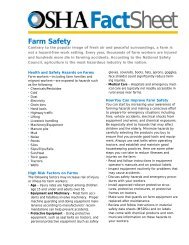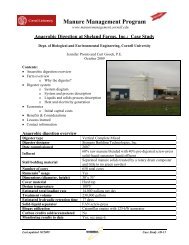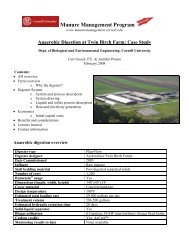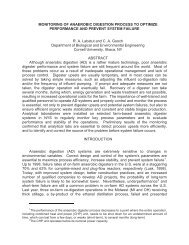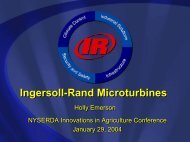Anaerobic Digester at Sunny Side Dairy - Manure Management
Anaerobic Digester at Sunny Side Dairy - Manure Management
Anaerobic Digester at Sunny Side Dairy - Manure Management
Create successful ePaper yourself
Turn your PDF publications into a flip-book with our unique Google optimized e-Paper software.
<strong>Manure</strong> <strong>Management</strong> Program<br />
www.manuremanagement.cornell.edu<br />
<strong>Anaerobic</strong> Digestion <strong>at</strong> <strong>Sunny</strong> <strong>Side</strong> <strong>Dairy</strong>, Inc.: Case Study<br />
Curt Gooch, P.E. and Jennifer Pronto<br />
Dept. of Biological and Environmental Engineering, Cornell University<br />
October 2009<br />
Contents:<br />
• AD overview<br />
• Farm overview<br />
o Why the digester?<br />
• <strong>Digester</strong> System<br />
o System and process description<br />
o Liquids and solids process<br />
description<br />
o He<strong>at</strong> and electricity gener<strong>at</strong>ion<br />
• Economics<br />
o Initial capital costs<br />
• Benefits & Consider<strong>at</strong>ions<br />
• Lessons learned<br />
• Contact inform<strong>at</strong>ion<br />
<strong>Anaerobic</strong> digestion overview<br />
<strong>Digester</strong> type<br />
Plug-flow with biogas recircul<strong>at</strong>ion<br />
<strong>Digester</strong> designer<br />
GHD<br />
D<strong>at</strong>e Commissioned May 2009<br />
Influent<br />
Raw manure<br />
Stall bedding m<strong>at</strong>erial<br />
Separ<strong>at</strong>ed manure solids<br />
Number of cows<br />
2,900 lact<strong>at</strong>ing cows + 1,400 heifers (designed for 4,400<br />
cow equivalents)<br />
Rumensin ® usage<br />
Yes; used on all dairy cows and all heifers<br />
Dimensions (width, length, height) 144’ x 240’ x 16’<br />
Cover m<strong>at</strong>erial<br />
Pre-cast concrete, spray foam insul<strong>at</strong>ion, spray sealer<br />
Design temper<strong>at</strong>ure 100°F<br />
Estim<strong>at</strong>ed total loading r<strong>at</strong>e 80,000 gallons per day<br />
Tre<strong>at</strong>ment volume<br />
3.76 x 10 6 gallons<br />
Estim<strong>at</strong>ed hydraulic retention time 57 days<br />
Solid-liquid separ<strong>at</strong>or<br />
Yes; separ<strong>at</strong>ed manure solids used for bedding<br />
Biogas utiliz<strong>at</strong>ion<br />
Guascor engine with 500-kW gener<strong>at</strong>or<br />
Carbon credits sold/accumul<strong>at</strong>ed No<br />
Monitoring results to d<strong>at</strong>e<br />
None available<br />
Last Upd<strong>at</strong>ed 2/2008<br />
Case Study AD-10
2<br />
Farm overview<br />
• <strong>Sunny</strong> <strong>Side</strong> <strong>Dairy</strong>, Inc. (Venice Center, NY) has been a family farm for three gener<strong>at</strong>ions,<br />
currently oper<strong>at</strong>ed by the managing partners Greg and Neil Rejman<br />
• The farm has 3,300 total milking age cows + 1,400 800 to 1,200 lbs heifers<br />
• The farm raises forage crops on 5,000 acres of land<br />
• <strong>Digester</strong> construction started in April 2008 with commissioning in May 2009.<br />
Why the digester?<br />
Well-designed and oper<strong>at</strong>ed anaerobic digestion systems can reduce a farm’s odor emissions,<br />
preserve nutrients in tre<strong>at</strong>ed manure for use by field crops, and reduce the risk of run-off and<br />
leaching of nutrients when properly applied to land with a growing crop in accordance with the<br />
governing comprehensive nutrient management plan (CNMP), and provide an offset of<br />
purchased power and he<strong>at</strong>ing fuels. The digester is also an integral component of an overall<br />
manure tre<strong>at</strong>ment system and allows the farm to be well positioned for future opportunities in<br />
manure tre<strong>at</strong>ment and renewable energy. These were the major drivers for constructing the<br />
digester along with the desire to continue being a good neighbor.<br />
<strong>Digester</strong> System<br />
System and process description<br />
The digestion system was designed by GHD. A detailed flow diagram of the system is provided<br />
on the following page. There are two parallel constructed and oper<strong>at</strong>ed anaerobic digestion<br />
vessels, each 72’ wide by 240’ long by 16’ deep with a 1.5’ biogas head space above the manure<br />
surface. Total processing capacity of the two units is 3.76 million gallons. Overall the digester<br />
vessels are designed to process manure from 4,400 cow equivalents with a design retention time<br />
of 20 days. Based on the current loading r<strong>at</strong>e of 2,900 lact<strong>at</strong>ing cows and most of the farm’s<br />
heifers, the daily influent volume is 65,000 gallons with resulting hydraulic retention time of 57<br />
days.<br />
The digester is designed to co-digest liquid substr<strong>at</strong>es and this may be pursued in the future. The<br />
concrete digester vessel and pre-digestion holding tanks and support buildings were constructed<br />
by contractors.<br />
Liquids and solids process description<br />
Cow and heifer barn manure alleys are cleaned with alley scrapers. Alley scrapers deposit<br />
collected manure in barn pump pits where it is subsequently pumped to a 75,000-gallon influent<br />
pit loc<strong>at</strong>ed adjacent to the digester. <strong>Digester</strong> feeding and mixing is performed autom<strong>at</strong>ically 24<br />
times per day by a Pro-Logic controller. A Vaughn 10-Hp pump is used to transfer m<strong>at</strong>erial<br />
from the influent pit to the digester.<br />
The digester solid top, constructed with pre-cast concrete insul<strong>at</strong>ed with spray foam, followed by<br />
a sealer, is used to contain the produced biogas. A portion of the collected biogas is re-circul<strong>at</strong>ed<br />
with a 40-Hp blower back into the digester vessel with the goal of providing in-vessel agit<strong>at</strong>ion.<br />
Case Study AD-16
3<br />
<strong>Digester</strong> effluent is processed with one of three FAN screw-press solid-liquid separ<strong>at</strong>ors.<br />
Separ<strong>at</strong>ed solids are used for freestall bedding and excess is either sold or land-applied. The<br />
screen size used is 0.75 mm. Separ<strong>at</strong>ed liquid flows by gravity to an intermedi<strong>at</strong>e long-term<br />
storage where it is stored or subsequently pumped to one of the farm’s s<strong>at</strong>ellite storages. Stored<br />
effluent is recycled to the farm’s cropland, following their comprehensive nutrient management<br />
plan (CNMP), using either liquid tankers or drag hose equipment, depending on the field loc<strong>at</strong>ion<br />
and time of year.<br />
He<strong>at</strong> and electricity gener<strong>at</strong>ion<br />
Electric blowers are used to pressurize the biogas before it is used primarily to fire the Guascor<br />
engine driving a 500-kW gener<strong>at</strong>or unit procured from Martin Machinery. Gener<strong>at</strong>ed power is<br />
used on-farm and excess is sold to the grid under the provisions of the New York St<strong>at</strong>e net<br />
metering law (see Fact Sheet No. NM-1). A 1.8-MW engine-gener<strong>at</strong>or set was initially ordered<br />
but the order had to be cancelled after the farm learned th<strong>at</strong> the local utility lines were not sized<br />
sufficiently to carry the extra power.<br />
A duel-fuel Columbia boiler (Pottstown, PA), with a 1.8 mmBtu/hr output r<strong>at</strong>ing, can be fired<br />
with biogas when the system calls for more he<strong>at</strong> than is reclaimed from the engine w<strong>at</strong>er jacket<br />
and exhaust. Excess biogas, which represents a significant portion of the overall amount, is<br />
flared thru one or two 12” power flares.<br />
A biogas hydrogen sulfide (H 2 S) scrubber was added in September, 2009 by Energy Cube, LLC<br />
to remove the majority of the H 2 S prior to utiliz<strong>at</strong>ion by the engine-gener<strong>at</strong>or set (see Figure 1).<br />
A lower biogas H 2 S concentr<strong>at</strong>ion reduces maintenance needs and resulting maintenance costs,<br />
therefore likely increasing the capacity factor. Based on a few measurements, biogas H 2 S<br />
concentr<strong>at</strong>ions before scrubbing were on average 4,000 ppm and post scrubbing were dropped to<br />
40 ppm.<br />
Figure1. Hydrogen Sulfide scrubber <strong>at</strong> <strong>Sunny</strong> <strong>Side</strong> <strong>Dairy</strong>.<br />
Case Study AD-16
4<br />
Economics<br />
The initial overall anaerobic digester system had a capital cost of $4.5 million or $1,023 per<br />
lact<strong>at</strong>ing cow equivalent (LCE).<br />
Benefits and Consider<strong>at</strong>ions<br />
Benefits<br />
• Odor control<br />
• Potential revenue from:<br />
1) Value-added products<br />
2) Reduction of purchased energy<br />
3) Sale of excess energy<br />
4) Food waste tipping fees<br />
5) Carbon credit sales<br />
• Nutrient conversion, allowing use by<br />
plants as a n<strong>at</strong>ural fertilizer, if effluent is<br />
spread <strong>at</strong> an appropri<strong>at</strong>e time<br />
• P<strong>at</strong>hogen reduction<br />
Consider<strong>at</strong>ions<br />
• Possible high initial capital and/or high<br />
oper<strong>at</strong>ing costs<br />
• Long and tedious contracts with the local<br />
utility; may require special equipment for<br />
interconnection<br />
• Dedic<strong>at</strong>ed management of the digestion<br />
system is required<br />
• Careful <strong>at</strong>tention to equipment<br />
maintenance and safety issues due to the<br />
characteristics of raw biogas<br />
• Increased land base may be required to<br />
handle the imported food waste nutrients<br />
• Specialized permits may be required to<br />
import food waste<br />
Lessons Learned<br />
The farm reported th<strong>at</strong> the following lessons were learned as a result of constructing and<br />
oper<strong>at</strong>ing their anaerobic digester for 9 months.<br />
Baby Steps: Compared to other on-farm capital construction projects, constructing an anaerobic<br />
digester took significantly more time from project conception to completion. <strong>Digester</strong> projects<br />
involve entities outside of a dairy producer's normal working circles th<strong>at</strong> added considerable time<br />
to the project. For a significant part of the project, overall progress needs to be viewed on wh<strong>at</strong><br />
is different this month than last and not wh<strong>at</strong> progress was made on a daily basis.<br />
Utility: Be sure to get all inform<strong>at</strong>ion in writing from the utility and have papers signed as<br />
needed. It is important to engage the utility early in the digester consider<strong>at</strong>ion stage as<br />
significant time is needed for the utility to work thru the steps they have to do in order for an<br />
interconnection to take place.<br />
Engine-gener<strong>at</strong>or set sizing: In addition to working with the digester designer and enginegener<strong>at</strong>or<br />
set supplier be sure to discuss engine-gener<strong>at</strong>or set sizing with the proper utility<br />
contact person. In our case, and <strong>at</strong> some other AD projects in the st<strong>at</strong>e as well, the size of the<br />
engine-gener<strong>at</strong>or set was ultim<strong>at</strong>ely limited by the size of the utility's electrical distribution<br />
system equipment and wiring.<br />
P<strong>at</strong>ience and Perseverance are keys to success: The abnormally long period experienced with<br />
the digester project required p<strong>at</strong>ience and perseverance but the effort so far has been worth it. At<br />
Case Study AD-16
5<br />
this point, overall we would do the project again. Five-finger waves from the neighbors when<br />
we spread digested manure on hay ground this summer was more welcome than fewer finger<br />
gestures we received in years past.<br />
Who to Contact<br />
• Greg Rejman, Partner, <strong>Sunny</strong> <strong>Side</strong> <strong>Dairy</strong>, Inc.<br />
Phone: 315-729-5841, e-mail: veniceview@msn.com<br />
• Curt Gooch, <strong>Dairy</strong> Housing and Waste Tre<strong>at</strong>ment Engineer, PRO-DAIRY Program, Cornell<br />
University. Phone: 607-255-2088, e-mail: cag26@cornell.edu<br />
Acknowledgements<br />
The authors would like to thank the New York St<strong>at</strong>e Energy Research and Development Authority (NYSERDA) for funding in support of this<br />
work. Any opinions, findings, conclusions or recommend<strong>at</strong>ions expressed in this public<strong>at</strong>ion are those of the authors and do not necessarily<br />
reflect the views of NYSERDA or the St<strong>at</strong>e of New York, and reflect the best professional judgment of the authors based on inform<strong>at</strong>ion<br />
available as of the public<strong>at</strong>ion d<strong>at</strong>e. Reference to any specific product, service, process, or method does not constitute an implied or<br />
expressed recommend<strong>at</strong>ion or endorsement of it. Further, Cornell University, NYSERDA and the St<strong>at</strong>e of New York make no warranties or<br />
represent<strong>at</strong>ions, expressed or implied, as to the fitness for particular purpose or merchantability of any product, appar<strong>at</strong>us, or service, or the<br />
usefulness, completeness, or accuracy of any processes, methods, or other inform<strong>at</strong>ion contained, described, disclosed, or referred to in this<br />
public<strong>at</strong>ion. Cornell University, NYSERDA and the St<strong>at</strong>e of New York make no represent<strong>at</strong>ion th<strong>at</strong> the use of any product, appar<strong>at</strong>us,<br />
process, method, or other inform<strong>at</strong>ion will not infringe priv<strong>at</strong>ely owned rights and will assume no liability for any loss, injury, or damage<br />
resulting from, or occurring in connection with, the use of inform<strong>at</strong>ion contained, described, disclosed, or referred to in this public<strong>at</strong>ion.<br />
Case Study AD-16



